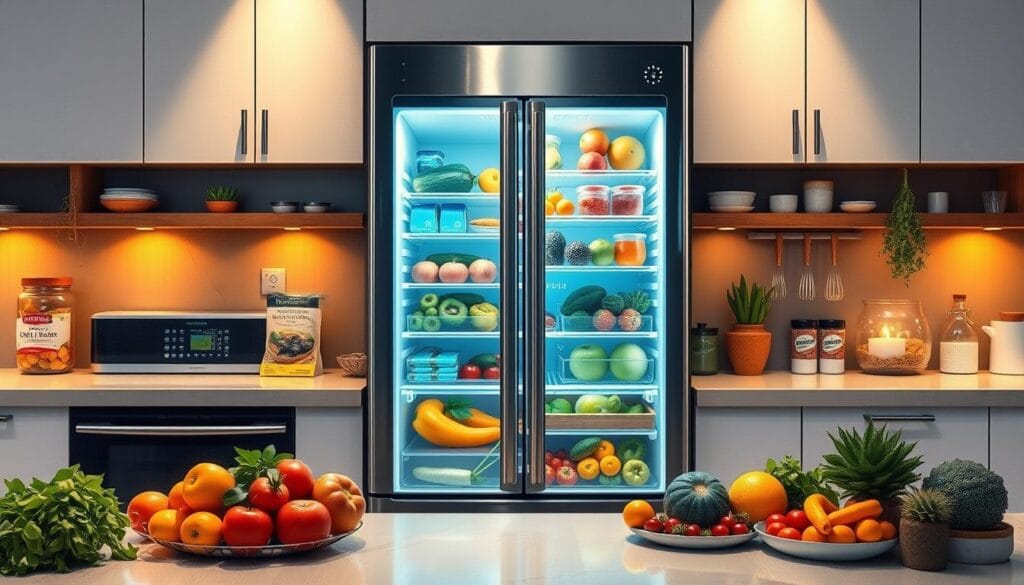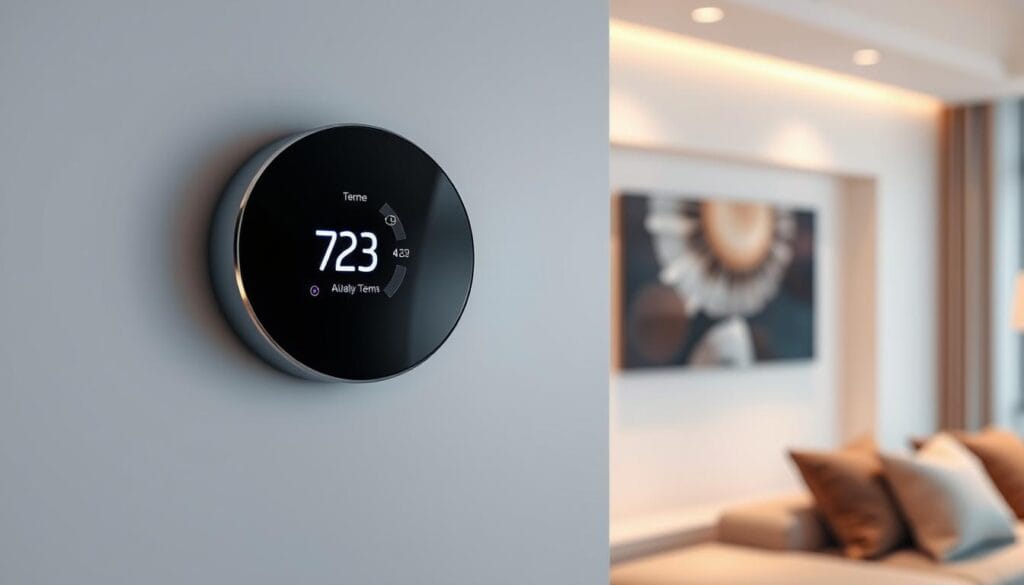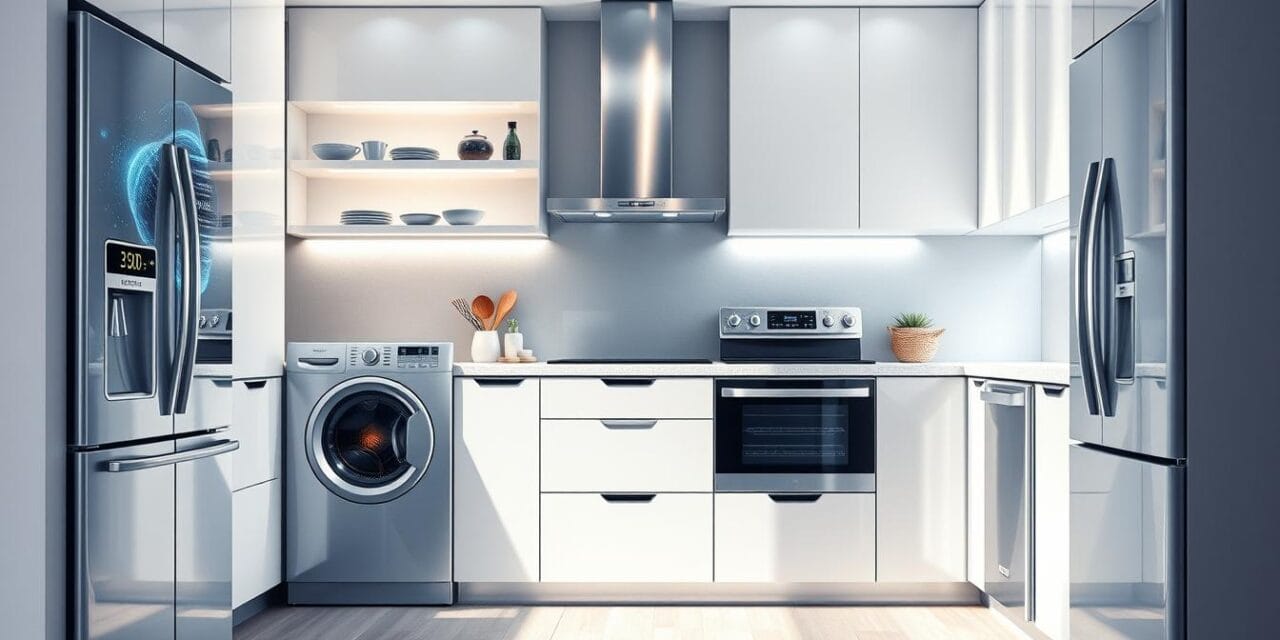Welcome to our smart appliance guide! We’re excited to explore the world of connected appliances and home automation with you. Smart home devices have changed our daily lives, making tasks easier and more efficient.
From smart refrigerators that keep track of groceries to washing machines you can control with your phone, these high-tech helpers are changing how we manage our homes. Let’s dive into the exciting realm of smart appliances and discover how they can make your life simpler.
Smart appliances connect to your home’s Wi-Fi, allowing you to control them remotely. Imagine preheating your oven while you’re shopping or starting a load of laundry from your office. These connected devices offer convenience, and energy savings, and even help reduce waste.
As we explore this guide, we’ll look at various smart home devices, their benefits, and how to choose the right ones for your needs. We’ll also check out some top brands like Samsung, LG, and Whirlpool, known for their innovative smart appliance lines.
Key Takeaways
- Smart appliances offer remote control and monitoring capabilities
- Connected devices can lead to energy savings and reduced waste
- Smart home automation enhances convenience in daily tasks
- Major brands like Samsung and LG are leaders in smart appliance technology
- Choosing compatible smart devices is key for a seamless smart home setup
Introduction to Smart Home Appliances
Smart home appliances are changing our homes. They make our lives easier and more efficient. Things like smart fridges and thermostats are making our homes smarter.
What Are Smart Home Appliances?
Smart home appliances are devices that connect to the internet. They let us control them from our phones. They can be anything from fridges that keep track of food to thermostats that adjust the temperature.
Key Features of Smart Home Appliances
Wi-Fi-enabled appliances have cool features:
- Remote operation via smartphone apps
- Energy efficiency through smart usage tracking
- Automation based on user preferences
- Integration with voice assistants
The Evolution of Home Automation
Home automation has grown a lot. It started with simple devices and now we have AI systems. Today, our appliances can guess what we need and work with other smart devices.
| Year | Advancement |
|---|---|
| 1975 | X10 home automation protocol introduced |
| 1998 | The first smart refrigerator unveiled |
| 2007 | iPhone launch sparks mobile control revolution |
| 2014 | Google acquires Nest, boosting smart thermostat market |
| 2022 | Matter standard launched for improved device compatibility |
Now, 44.4% of US homes use smart devices. This shows that smart homes are here to stay. As we keep using these technologies, our homes will get smarter, safer, and more comfortable.
Benefits of Smart Home Appliances
Smart home appliances make our lives better. They use new tech to make our homes work better. They turn our homes into smart, connected places.
One big plus is saving energy. Smart appliances use sensors to use less power. For example, smart washers use less water based on how full they are. Smart fridges save energy by letting you see what’s inside without opening it.
They also make life easier. You can control them from anywhere with Wi-Fi. Start the dishwasher or oven from work. This saves time and makes our days smoother.
They work together to make our homes better. They talk to each other and set things up for us. Imagine your coffee ready when your alarm goes off. That’s what smart homes do.
| Feature | Benefit |
|---|---|
| Remote Control | Manage appliances from anywhere |
| Energy Monitoring | Reduce utility bills |
| Personalized Settings | Tailored user experience |
| Automated Updates | Improved functionality over time |
Smart appliances get better over time. They get new features and updates. They also show us how we use them, helping us use less.
They might cost more at first, but they save money in the long run. As they get more common, they’re becoming cheaper. This means more people can have smart homes.
Smart Appliance Guide: Choosing the Right Devices for Your Home
Choosing the right smart appliances for your home is exciting but can be hard. Our guide will help you make smart choices for your home. We’ll look at important things to think about when picking smart devices that fit your life.
Assessing Your Needs
First, think about your daily life and what smart tech can improve. Decide which tasks you want to make easier or control from afar. For example, a smart thermostat can keep your home’s temperature just right. A Furbo 360 Dog Camera can watch your pets when you’re not there.
Compatibility Considerations
Your devices need to work well together. Make sure they match your voice assistant and smart home setup. If you use Alexa, the Amazon Echo (4th Gen) is a good pick. Apple HomeKit users might like the Apple HomePod mini.
Budget Planning for Smart Appliances
Smart home tech doesn’t have to cost a lot. Many affordable smart devices have cool features without a high price. For example, Govee Wi-Fi LED Bulbs are cheaper than some smart lights. The WiZ Smart Plug is a budget-friendly way to control other devices.
| Device Type | Budget-Friendly Option | Premium Option |
|---|---|---|
| Smart Lights | Govee Wi-Fi LED Bulbs | Philips Hue Color Ambiance |
| Smart Plug | WiZ Smart Plug | Eve Energy Smart Plug |
| Security Camera | Eufy S220 Indoor Cam | Ring Indoor Cam (2nd Gen) |
Think about your needs, make sure devices work together, and plan your budget. This will help you create a smart home that’s both useful and fun.
Smart Refrigerators: The Heart of the Connected Kitchen
Smart fridges are changing our kitchens. They make life easier and more efficient. Let’s see how they’re changing food management and home organization.
Internal Cameras and Inventory Management
Smart fridges have cameras inside. You can see what’s inside from anywhere. No more wondering what’s in the fridge while you shop.
Some fridges even track what you have. They suggest recipes and make grocery lists for you.

Touchscreen Interfaces and Family Organization
Many smart fridges have big touchscreens on the door. They’re like digital hubs for the family. You can leave notes, sync calendars, and stream music or videos.
The Samsung Family Hub is a great example. It costs $2,499 at Lowe’s.
Energy Efficiency Features
Smart fridges save energy. They cool better and alert you if the door is open. Some, like the LG InstaView™ Refrigerator, use special tech to save energy.
| Model | Price | Key Features |
|---|---|---|
| Samsung Family Hub | $2,499 | Touchscreen, Internal Cameras, Family Organization |
| LG InstaView™ | $1,999 | Energy Efficient, Knock-to-View Door |
| GE Profile™ Smart | $3,199 | Fingerprint Resistant, Wi-Fi Enabled |
Smart fridges are making our kitchens better. They help with food management, family organization, and save energy. They’re the heart of the modern home.
Revolutionizing Laundry with Smart Washers and Dryers
Smart washers and dryers are changing laundry forever. They save time, energy, and money. They also make doing laundry super easy.
Remote laundry management is amazing. We can start and check on our laundry with apps. This lets us save energy by using machines when it’s cheaper.
These appliances are also very good at saving energy. They use just the right amount of water and power. For example:
- Smart washers use high-spin speeds to reduce drying time
- Heat pump dryers consume less energy than conventional models
- Many are ENERGY STAR certified, meeting strict efficiency guidelines
They also have cool features like steam and allergen cycles. Steam gets rid of tough stains and wrinkles. Allergen cycles kill common allergens with high heat.
They even tell us when something might go wrong. This helps us fix problems before they happen. It makes our appliances last longer.
Laundry technology has come a long way. We’ve gone from washboards to smart, connected machines. These new machines are all about being efficient and easy to use.
“Smart laundry appliances are not just about convenience; they’re about creating a more sustainable and efficient home.”
Using these smart appliances makes laundry easier. It also helps our planet.
Smart Ovens and Ranges: Precision Cooking at Your Fingertips
Smart ovens and connected ranges change how we cook. They bring new tech to our kitchens. This makes cooking easier and more precise.
Remote Preheating and Monitoring
Smart ovens let us control cooking from afar. We can preheat the oven on our way home. Dinner is ready when we arrive.
We can check the oven’s temperature in real time. This ensures our food cooks perfectly, even if we’re not there.
Guided Cooking and Recipe Integration
Guided recipes make cooking simple. Smart ovens offer step-by-step help. Some even suggest recipes based on what we like and what’s in our fridge.
This is great for beginners or anyone wanting to try new things.
Self-Cleaning Technologies
Cleaning the oven is now easy. Many smart ovens have self-cleaning features. They use heat or steam to remove grime, making cleaning simple.
| Feature | Benefit |
|---|---|
| Remote Preheating | Save time and start cooking immediately |
| Guided Recipes | Improve cooking skills and try new dishes |
| Self-Cleaning | Effortless maintenance and cleaning |
Smart ovens and ranges are more than appliances. They are our kitchen partners. They help us make tasty meals easily and precisely. As tech gets better, our kitchens will too.
The Future of Dishwashing: Smart Dishwashers
Smart dishwashers are changing how we clean dishes. They have cool features for easy and efficient washing. About 20% of dishwashers now have WiFi, showing the future is here.
Being able to control your dishwasher from your phone is amazing. You can start, stop, or check on cycles from your phone. LG’s ThinQ app even lets you download special cycles for different dishes.
Smart dishwashers do more than just start and stop. They adjust cycles based on how dirty your dishes are and how many you have. Some, like Home Connect, have an “Easy Start” feature that suggests the best cycle for your dishes.
They also keep track of how much detergent you have. They’ll tell you when it’s time to buy more. Some even order more for you when it’s needed.
“Smart dishwashers are not just about convenience. They’re about efficiency, sustainability, and integrating seamlessly into our connected homes.”
Let’s explore some cool features of smart dishwashers:
| Feature | Benefit |
|---|---|
| Remote Control | Start, stop, or monitor cycles from anywhere |
| Cycle Optimization | Recommends the best cycle based on load |
| Detergent Tracking | Notifies when detergent is low |
| Leak Detection | Alerts users to possible problems |
Smart dishwashers have lots of good points. But, not all can be started remotely. This depends on the brand and model. So, always check the specs when looking for a smart dishwasher.
Smart Thermostats: Optimizing Home Comfort and Energy Use
Smart thermostats are changing how we control our homes’ climate. They mix comfort with saving energy. This change is big for how Americans heat and cool their homes.
Learning Capabilities and Adaptive Scheduling
Smart thermostats are great at learning and adjusting. They get to know your habits and likes. Then, they make a schedule for the best comfort without wasting energy.

Integration with Other Smart Home Systems
Smart thermostats work well with other smart home gadgets. They make a system for controlling your home’s climate. You can manage your HVAC from anywhere, keeping your home comfy and efficient.
Energy Savings and Usage Reports
Smart thermostats help save a lot of energy. The average home spends over $900 a year on heating and cooling. Smart thermostats can save up to $100 a year. They also give detailed reports on energy use, helping you use less.
| Feature | Benefit |
|---|---|
| Adaptive Scheduling | Optimizes comfort and energy use |
| Smart Home Integration | Unified control of home systems |
| Energy Reports | Insights for better energy management |
| Remote Access | Control from anywhere |
Using smart thermostats saves money and helps the planet. If all homes used ENERGY STAR-certified smart thermostats, we could cut 13 billion pounds of greenhouse gas emissions a year. This is a big step towards saving energy and protecting our environment.
Setting Up Your Smart Home: Installation and Connectivity
Setting up a smart home is fun and rewarding. We’ll show you how to do it right. You’ll learn about installation and Wi-Fi connectivity.
First, check your Wi-Fi. It needs to be strong for all your smart devices. If it’s not, get a better router or a mesh system. Most devices use 2.4 GHz, but some newer ones use 5 GHz.
Then, pick a central hub for your devices. You can choose from Google Home, Amazon Alexa, or Apple HomeKit. Each has its own special features:
- Google Assistant: Quick answers and great device connection
- Amazon Alexa: Lots of compatible products
- Apple HomeKit: Easy to use and safe
For the hub, think about Samsung SmartThings or Tuya Smart Life. They work well with big systems and help manage devices.
When picking smart appliances, check for logos on the packaging. This means they’ll work well with your hub. Start with just a few devices to get used to it.
Read the instructions carefully when setting up devices. Some connect directly to Wi-Fi, while others need a hub for control.
| Connectivity Method | Advantages | Considerations |
|---|---|---|
| Direct Wi-Fi | Easy setup, no extra hardware | May make the network slow with many devices |
| Smart Hub | Easy to control, keeps network fast | Costs more, and can be harder to set up |
| Bluetooth | Uses little power | Short range, fewer features |
After setup, make routines for your smart home. Use devices for morning routines or to save energy. A well-set-up smart home can save you $150 a year on bills.
Top Brands in the Smart Appliance Market
The smart appliances market is growing fast. It’s expected to go from $33.8 billion in 2021 to $76.4 billion by 2026. Let’s look at some top brands making our homes smarter.
Samsung and the SmartThings Ecosystem
Samsung’s SmartThings is a big name in smart appliances. Their Family Hub refrigerator is very innovative. It has cameras and a touchscreen for organizing your family.
LG’s ThinQ Technology
LG ThinQ makes it easy to control smart appliances. You can use one app to manage things like washing machines and ovens. It makes your home smarter and easier to manage.
Whirlpool’s Connected Appliance Suite
Whirlpool’s smart appliances make daily tasks easier. They have cool features like Scan-to-Cook in microwaves and remote laundry control. It makes doing chores more efficient.
| Brand | Key Features | Popular Product |
|---|---|---|
| Samsung | SmartThings ecosystem | Family Hub refrigerator |
| LG | ThinQ platform | LG InstaView refrigerator |
| Whirlpool | Connected appliance suite | Smart Front Load Washer |
Wi-Fi technology is leading the smart appliances market. These brands are making our homes more connected and easier to live in. As the market grows, we’ll see even more cool features from these leaders.
Conclusion
The smart home future is here, changing our lives. We’ve seen many smart appliances that are changing how we live. Brands like Samsung, LG, and Bosch are leading in new tech.
Smart appliances now have cool features like cameras in fridges and ovens that start from afar. They save energy, make our homes safer, and last longer. We can now control our homes from anywhere, making life easier.
Soon, our homes will talk to us and help us save energy. These smart homes will be more comfy and meet our needs better. The smart home revolution is starting, and it’s going to be amazing.
FAQ
What are smart home appliances?
Smart home appliances are devices that connect to the internet. They can be controlled from anywhere and learn your habits. They offer remote control, save energy, and automate tasks.
What are the benefits of smart home appliances?
Smart appliances make life easier with remote control and monitoring. They save energy, which lowers your bills. They also have cool features like cameras in fridges and security alerts.
How do I choose the right smart appliances for my home?
First, think about what you need and how you live. Check if they work with your current smart systems and voice assistants. Look at how long they last and if they can update. Think about the cost, including savings on energy and convenience.
What features do smart refrigerators offer?
Smart fridges have cameras to see inside, touch screens for planning meals, and save energy. They help you keep track of food, suggest recipes, and make shopping lists.
How do smart washers and dryers work?
Smart washers and dryers let you control them from afar and track energy use. They learn your habits to suggest the best settings. They can also run when it’s cheaper to save energy.
What are the benefits of smart ovens and ranges?
Smart ovens and ranges let you preheat and check on food from anywhere. They guide you through cooking, work with recipe apps, and have healthier cooking options. They also clean themselves.
What features do smart dishwashers have?
Smart dishwashers let you pick cycles and track energy use from afar. They remind you when to buy detergent, suggest cycles based on how dirty they are, and let you customize cleaning.
How do smart thermostats work?
Smart thermostats learn your habits to save energy and keep you comfortable. They work with other smart devices, adjust based on if you’re home, show energy use, and can be controlled from anywhere.
What should I consider when setting up a smart home?
Setting up a smart home needs careful planning. Make sure your Wi-Fi is strong, consider a central hub, follow the instructions for each device, and set up routines for the best use.
What are some top brands in the smart appliance market?
Top brands include Samsung, LG, Whirlpool, Bosch, and GE Appliances. They offer a range of smart features and work well with other smart devices.
Recommended Reading: The Best Smart Appliances for 2025 for a Modern Kitchen









Trackbacks/Pingbacks